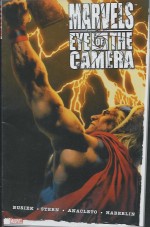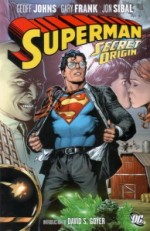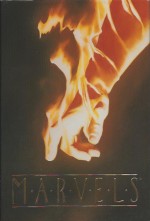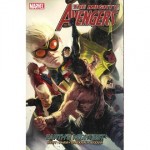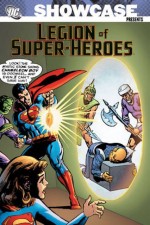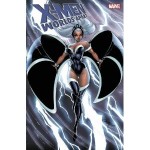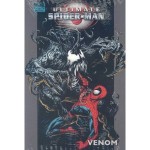
By Brian Michael Bendis, Mark Bagley, Art Thibert & Rodney Ramos (Marvel)
ISBN: 978-0-7851-2873-1
After Marvel’s financial – and indeed creative – problems in the later 1990s, the company came back swinging. A key new concept was the remodelling and modernising of their core characters for the new youth culture. The ‘Ultimate‘ imprint abandoned the monumental continuity which had always been Marvel’s greatest asset, and the company’s major characters were given a separate universe to play in, with varying degrees of radical makeover to appeal to a contemporary 21st century audience.
Peter Parker was once again a nerdy high-school geek, brilliant but bullied by his physical superiors, and there was a fresh and fashionable, more modern and scientifically feasible rationale for the spider bite which imparted impossible arachnoid abilities.
Uncle Ben still died because of his lack of responsibility. The Daily Bugle was still there as was the outrageous J. Jonah Jameson. But now in a more cynical, litigious world, well-used to cover-ups and conspiracy theories, arch-foe Norman Osborn – a corrupt, ruthless billionaire businessman – was behind everything.
Any gesture towards the faux-realism of traditional superhero fare was surrendered to a tried-and-tested soap-opera melodrama that inevitably links all characters together in invisible threads of karmic coincidence and familial consanguinity, but, to be honest, it seldom hurt the narrative. After all as long as internal logic isn’t contravened, subplots don’t have to make sense to be entertaining.
By reworking key moments of Lee & Ditko’s Spider-Man – and their myriad successors – writer Brian Michael Bendis and illustrator Mark Bagley succinctly captured the core values of the original and certainly re-cast in it terms that newer readers readily assimilated. The Ultimate Peter Parker spoke to modern teen readers in the same way the 1960s incarnation spoke to me and my peers…
Collecting issues #33-39 of Ultimate Spider-Man from 2003, this premiere hardcover edition introduces an alternative vision for the web-spinner’s most memorable foe of recent vintage, and upped the angst-quotient by revealing untold connections with Peter’s long-dead parents.
The convoluted, clotted web of coincidence and continuity which had eventually bogged down the original Spider-Man was just beginning to creep into these tales, but perhaps that’s unavoidable if you’re concocting contemporary super-heroics.
What you need to know: Parker is the perennial hard-luck loser kid, a brilliant geek just trying to get by in a world where daily education is infinitely more scary than monsters and villains. His alter ego’s already shaky reputation has been destroyed by a burglar, who impersonated Spider-Man, went on a very public crime-spree and murdered Police Captain George Stacy.
Whilst Peter was dealing with the deadly doppelganger his widowed Aunt May was inviting Stacy’s orphaned daughter Gwen to move into the Parker household. In the aftermath Pete’s girlfriend and confidante Mary Jane Watson dumped him, unable to deal with the constant stress of having an underage superhero and perpetually potential corpse for a lover…
Shell-shocked and emotionally gutted by his bad break-up, Peter broods and mopes around the house until he finds an old box of junk which contains notes and video tapes of his 5-year old self and his parents; dead for a decade in a plane crash.
The idyllic scenes show a picnic in the park, attended by geneticists Richard and Mary Parker, their research partners the Brocks, Uncle Ben and Aunt May. Although he had forgotten, Eddie Brock Jr., despite being an older kid, was young Pete’s best friend for years – almost a brother…
Eddie’s folks had also died in the crash and the boy had been forced to leave the city and live with his grandparents.
All fired up, Peter tracks down Eddie and, discovering he’s now a student at Empire State University, resolves to find his old buddy and show him the tapes. So eager is the Arachnid kid that he doesn’t even glance at the notes and files in the box: enigmatic records pertaining to an incredible, radical cancer-cure code-named the Venom Project…
Under the tutelage of Dr. Curt Connors (whom Spidey once battled when the scientist temporarily mutated into a sentient Lizard), Eddie has grown into the coolest guy imaginable: a science student carrying on their father’s work and a player with lots of great-sounding advice about girls…
At the end of a great day on Campus, Eddie takes Peter to the labs and shows his bro-besotted pal “the work†– a shared inheritance from their departed fathers which will change the world forever…
The miracle-cure is a gloopy black liquid based on Ray Parker’s DNA: designed to coat a cancer sufferer’s entire body in a living bio-suit that would boost the victim’s system and repair organic malfunctions, and as Eddie shows it off he also discloses how corporate skulduggery scuttled the bold project even before the groundbreaking technologists died in that mysterious crash…
The suspicious and embittered Brock has spent years reconstructing the project using notes and samples kept by his grandfather. Now the student is close to total, vindicating success…
Back in High School Pete wants to confront Mary Jane, but Gwen advises against it. However when college-guy Eddie shows up in flashy sports car she joins the distracted Parker in another jaunt to ESU…
Fuming for hours at the imagined cause of his parents’ death and how well Gwen is getting on with Eddie, Parker breaks into the university labs to “obtain†his own test samples of the Venom prototype and is horrified when the goo attacks and utterly envelops his body…
That night, a new Spider-Man rampages through New York, clad in deepest black. Stronger, faster, tougher, far more reckless and wild and spectacularly crushing crimes big and small. After brutally foiling a celebrity kidnapping and easily trashing super-villain the Shocker, the dark Spider tackles a petty thief who reminds him of Uncle Ben’s killer and, lost in an emotional flashback, mutates into a fanged horror which tries to eat the gun-toting thug…
Petrified and aghast, Peter comes to his senses in time and tries to escape but the suit won’t let him go until the panicked lad blunders into high tension power cables and crashes to earth in the cemetery where his parents are buried…
Eddie is far from the cool guy he seems. After trying to take advantage of Gwen the frustrated frat boy sees TV footage of the Black Spider-Man and puts the pieces together. Rushing to the lab he finds Peter with the Venom sample and demands to know everything. Peter’s desperate warnings seem to hit home and he allows Parker to destroy the potentially homicidal sludge. Returning home he finds the still-shaking Gwen who tells him what Eddie did and slowly realises that his childhood friend might not be the paragon he imagined…
Brock meanwhile has retrieved another sample in his ongoing series of Venom experiments and activated it with his own body…
Plagued by nightmares, Peter seeks out Mary Jane who again rejects him and his dangerous lifestyle, whilst at ESU Eddie’s rash act has already cost the life of the cleaning woman who tried to help the mewling ebony mess on a lab floor.
Next day at Midtown High, Peter’s Spider-Sense alerts him to incredible peril and he realises that the suit has copied his memories and passed them on. Eddie has become a ravening, shape-shifting carnivorous version of Spider-Man, fuelled by a now unsuppressed psychotic paranoia and hatred…
With Richard Parker’s video-taped fears and misgivings on the Venom Project and life in general echoing in his head, Peter confronts the exultant, mutated Eddie and is soundly thrashed. The big black beast is going wild: slaughtering cops and civilians, whilst only really craving Peter. The savage suit is madly trying to reunite with Peter’s memories and Parker DNA…
In the pointless battle that follows, the monstrous avatar is vaporised by lightning and Peter flees. Dodging cops who want to arrest him for his various impostors’ crimes, the totally traumatised kid runs straight into the formidable Nick Fury.
The Director of covert security agency S.H.I.E.L.D. is the government’s go-to guy: responsible for superhuman affairs and crises. Moreover he had previously threatened to draft Spider-Man once he turned eighteen…
Despondent and dejected, the boy surrenders and begs to be cured of the curse of Arachnid powers, but instead receives an unexpected and life-changing pep-talk… Bewildered Peter again breaks into the ESU lab and meets Dr. Connors, wearily examining the vaults from which all the remaining Venom samples have been removed…
This version of the Wondrous Wall-crawler is very close to the movie iteration – surely a welcome benefit for all converts from celluloid to paper adventuring – and this book also includes added value features ‘Venom Arc Outline’ and 8 pages of beautiful Bagley pencils for the assorted comics and collection covers.
Moody and scary, but far more-concerned with angst-ridden melodrama than Fights ‘n’ Tights action, this thriller ends on a pensive, low-key and unsatisfactorily inconclusive note, deferring the eventual, inevitable showdown with the Venom-Brock amalgam to another day and leaving tragic Peter Parker even more conflicted and confused than before…
And that’s probably the point. Frenetic and compelling, the geeky charisma of the misunderstood alienated outsider fuels and permeates this readable pot-boiler of turbulent teen-tribulation and fashionable school-daze. Light yet addictive, this glossy super-soap brings great comics entertainment to the post-literate generation.
© 2003, 2007 Marvel Characters, Inc. All Rights Reserved.

